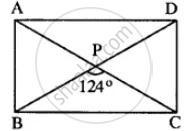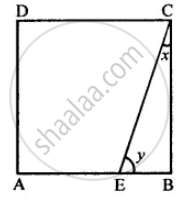Advertisements
Advertisements
प्रश्न
Which of the following statement is true for a rectangle?
Its diagonals are equal and perpendicular, and bisect each other.
उत्तर
False
The diagonals are not perpendicular to each other.
APPEARS IN
संबंधित प्रश्न
Two adjacent angles of a parallelogram are (3x − 4)° and (3x + 10)°. Find the angles of the parallelogram.
In a parallelogram ABCD, the diagonals bisect each other at O. If ∠ABC = 30°, ∠BDC = 10° and ∠CAB = 70°. Find:
∠DAB, ∠ADC, ∠BCD, ∠AOD, ∠DOC, ∠BOC, ∠AOB, ∠ACD, ∠CAB, ∠ADB, ∠ACB, ∠DBC and ∠DBA.
Fill in the blank of the following, so as to make the statement true:
A square is a rectangle in which .....
The sides of a rectangle are in the ratio 2 : 3, and its perimeter is 20 cm. Draw the rectangle.
Draw a square whose each side measures 4.8 cm.
ABCD is a rectangle, if ∠BPC = 124°
Calculate:
- ∠BAP
- ∠ADP

The following figure is a rectangle in which x: y = 3: 7; find the values of x and y.

If the adjacent angles of a parallelogram are equal, then the parallelogram is a ______.
A parallelogram PQRS is constructed with sides QR = 6 cm, PQ = 4 cm and ∠PQR = 90°. Then PQRS is a ______.
Rectangle is a regular quadrilateral.
